A Study on the Characteristics of the Ionospheric Gradient under Geomagnetic Perturbations
Abstract
1. Introduction
2. Data and Methodology
2.1. Data Representation
2.2. Calculation of the TEC and the Ionospheric Gradient
2.3. One Sigma Bound of the Ionospheric Gradient
3. Experimental Results
3.1. General Morphology of the Geomagnetic Storm
3.2. Responses of the Ionospheric Gradient
3.2.1. Ionospheric Gradient under Geomagnetically Quiet Conditions
3.2.2. Ionospheric Gradient under the Geomagnetic Storm
3.3. Ionospheric Variability in Different Regions
4. Discussion
5. Conclusions
- The ionospheric gradient decreased greatly from the auroral region to the middle latitudes for all the periods considered, especially during the geomagnetic storm, when the overbound values drastically increased; the maximum ionospheric gradient discovered in the American region approached 980 mm/km at 01:07 UT at the baseline range 25–30 km. The value exceeded the ionospheric gradient discovered at Brazil low latitudes by [15,16]. The large ionospheric gradients were concentrated in the main phase of the geomagnetic storm. The result is probable attributed to the ionospheric irregularities generated by the geomagnetic storm, leading to the spatial ununiform of ionosphere TEC.
- The ionospheric gradient was dependent on the baseline distance and usually decreased with increasing baseline distance. As a key parameter to indicate GBAS integrity hazard, the overbound value showed similar variability and acted as statistical indicator of ionospheric gradient. The overbound value derived for baseline distances less than 10 km was several times larger than those derived for baseline distances larger than 10 km. It decreased to less than 12 mm/km when the baseline distance exceeded 15 km under geomagnetically quiet conditions, which was consistent with a pervious study conducted in Thailand airport [18]. The standard deviation of the ionospheric gradient stayed below 4 mm/km for all the considered cases on geomagnetically quiet days, which was consistent with previous investigations of the solar cycle 23 [7,8,29].
- The overbound value exhibited great variabilities corresponding to the baseline distance under the geomagnetic storm. In this storm case, it fluctuated in both the sub-auroral region and the middle latitudes. Two probable reasons were attributed to the following: First, the ionospheric irregularities generated by the storm induced PPEF, and these irregularities were responsible for large ionospheric gradients according to previous studies [12,19,36,37,38,39]; second, the MSTID accompanied the geomagnetic storm, and similar feature has been noticed in Asia during the MSTID on 10 November 2004 [20,30].
- The overbound values observed during this geomagnetic storm showed hemispherical asymmetry, with the values in America being the most dominant, which showed consistency with the results of [26]. A probable explanation for this correlation is the geographical factor, that is, America covers both the auroral and sub-auroral regions, thereby contributing large values of to the overall results. Moreover, the monthly variability of the overbound values for America, Australia, and New Zealand also indicated the strong impact of geomagnetic perturbations on the formation and magnitude of ionospheric gradients.
- The standard deviation of the ionospheric gradient during geomagnetically quiet days decreases with increasing baseline distance, within 4 mm/km for the considered cases in this work; while it increases drastically under geomagnetic disturbance, and shows inconsistency when the baseline distance between 15 and 20 km on 7 September, after a X-class solar flare and before a geomagnetic storm on 8 September. Similar features were discovered on the storm day, 8 September, when the baseline distance was 15 to 20 km in the sub-auroral region and the baseline distance was 20 to 25 km in the middle latitudes.
Author Contributions
Funding
Acknowledgments
Conflicts of Interest
References
- Le, H.; Liu, L.; He, H.; Wan, W. Statistical analysis of solar EUV and X-ray flux enhancements induced by solar flares and its implication to upper atmosphere. J. Geophys. Res. Atmos. 2011, 116. [Google Scholar] [CrossRef]
- Nicolet, M.; Aikin, A. The formation of the D region of the ionosphere. J. Geophys. Res. 1960, 65, 1469–1483. [Google Scholar] [CrossRef]
- Yeh, K.; Liu, C. Radio wave scintillations in the ionosphere. Proc. IEEE 1982, 70, 324–360. [Google Scholar]
- Chen, W.; Gao, S.; Hu, C.; Chen, Y.; Ding, X. Effects of ionospheric disturbances on GPS observation in low latitude area. GPS Solut. 2008, 12, 33–41. [Google Scholar] [CrossRef]
- Datta-Barua, S.; Lee, J.; Pullen, S.; Luo, M.; Ene, A.; Qiu, D.; Zhang, G.; Enge, P. Ionospheric Threat Parameterization for Local Area Global-Positioning-System-Based Aircraft Landing Systems. J. Aircr. 2010, 47, 1141–1151. [Google Scholar] [CrossRef]
- Dautermann, T.; Felux, M.; Grosch, A. Approach service type D evaluation of the DLR GBAS testbed. GPS Solut. 2012, 16, 375–387. [Google Scholar] [CrossRef]
- Graw, M.; Gary, A.; Murphy, T.; Brenner, M.; Pullen, S.; Van Dierendonck, A.J. Development of the LAAS Accuracy Models. In Proceedings of the 13th International Technical Meeting of the Satellite Division of The Institute of Navigation (ION GPS 2000), Salt Lake City, UT, USA, 19–22 September 2000; pp. 1212–1223. [Google Scholar]
- Konno, H.; Pullen, S.; Luo, M.; Enge, P. Analysis of Ionosphere Gradient Using Japan GEONET Data. In Proceedings of the 2005 National Technical Meeting of The Institute of Navigation, San Diego, CA, USA, 24–26 January 2005; pp. 1118–1129. [Google Scholar]
- Blanc, M.; Richmond, A.D. The ionospheric disturbance dynamo. J. Geophys. Res. Space Phys. 1980, 85, 1669–1686. [Google Scholar] [CrossRef]
- Fuller-Rowell, T.; Codrescu, M.; Moffett, R.; Quegan, S. Response of the thermosphere and ionosphere to geomagnetic storms. J. Geophys. Res. 1994, 99, 3893. [Google Scholar] [CrossRef]
- Liu, Y.; Li, Z.; Fu, L.; Wang, J.; Radicella, S.M.; Zhang, C. Analyzing Ionosphere TEC and ROTI Responses on 2010 August High Speed Solar Winds. IEEE Access 2019, 7, 29788–29804. [Google Scholar] [CrossRef]
- Liu, Y.; Fu, L.; Wang, J.; Zhang, C. Studying Ionosphere Responses to a Geomagnetic Storm in June 2015 with Multi-Constellation Observations. Remote Sens. 2018, 10, 666. [Google Scholar] [CrossRef]
- Kil, H.; Paxton, L.; Kim, K.; Park, S.; Zhang, Y.; Oh, S. Temporal and spatial components in the storm-time ionospheric disturbances. J. Geophys. Res. Space Phys. 2011, 116. [Google Scholar] [CrossRef]
- Komjathy, A.; Sparks, L.; Mannucci, A.; Coster, A. The ionospheric impact of the October 2003 storm event on Wide Area Augmentation System. GPS Solut. 2005, 9, 41–50. [Google Scholar] [CrossRef]
- Lee, J.; Dattabarua, S.; Zhang, G.; Pullen, S.; Enge, P. Observations of low-elevation ionospheric anomalies for ground-based augmentation of GNSS. Radio Sci. 2011, 46, 1–11. [Google Scholar] [CrossRef]
- Jung, S.; Lee, J. Long-term ionospheric anomaly monitoring for ground based augmentation systems. Radio Sci. 2012, 47, 1–12. [Google Scholar] [CrossRef]
- Pullen, S.; Park, Y.; Enge, P. Impact and Mitigation of Ionospheric Anomalies on Ground-Based Augmentation of GNSS. Radio Sci. 2009, 44. [Google Scholar] [CrossRef]
- Pradipta, R.; Doherty, P. Assessing the Occurrence Pattern of Large Ionospheric TEC Gradients over the Brazilian Airspace. Navigation 2016, 63, 335–343. [Google Scholar] [CrossRef]
- Yoon, M.; Lee, J.; Pullen, S.; Gillespie, J.; Mathur, N.; Cole, R. Equatorial Plasma Bubble Threat Parameterization to Support GBAS Operations in the Brazilian Region. Navigation 2017, 64, 309–321. [Google Scholar] [CrossRef]
- Yoon, M.; Lee, J. Medium-scale traveling ionospheric disturbances in the Korean region on 10 November 2004: Potential impact on GPS-based navigation systems. Space Weather. 2014, 12, 173–186. [Google Scholar] [CrossRef]
- Saito, S.; Sunda, S.; Lee, J.; Pullen, S.; Supriadi, S.; Yoshihara, T.; Terkildsen, M.; Lecat, F. Ionospheric delay gradient model for GBAS in the Asia-Pacific region. GPS Solut. 2017, 21, 1937–1947. [Google Scholar] [CrossRef]
- Felux, M.; Lee, J.; Holzapfel, F. GBAS ground monitoring requirements from an airworthiness perspective. GPS Solut. 2015, 19, 393–401. [Google Scholar] [CrossRef]
- Rungraengwajiake, S.; Supnithi, P.; Saito, S.; Siansawasdi, N.; Saekow, A. Ionospheric delay gradient monitoring for GBAS by GPS stations near Suvarnabhumi airport, Thailand. Radio Sci. 2015, 50, 1076–1085. [Google Scholar] [CrossRef]
- Budtho, J.; Supnithi, P.; Saito, S. Analysis of quiet-time vertical ionospheric delay gradients around Suvarnabhumi Airport, Thailand. Radio Sci. 2018, 53, 1067–1074. [Google Scholar] [CrossRef]
- Rizos, C.; Satirapod, C. Contribution of GNSS CORS Infrastructure to the Mission of Modern Geodesy and Status of GNSS CORS in Thailand. Eng. J. 2011, 15, 25–42. [Google Scholar] [CrossRef]
- Kim, M.; Choi, Y.; Jun, H.S.; Lee, J. GBAS ionospheric threat model assessment for category I operation in the Korean region. GPS Solut. 2015, 19, 443–456. [Google Scholar]
- Saito, S.; Yoshihara, T. Evaluation of extreme ionospheric Total Electron Content (TEC) gradient associated with plasma bubbles for GNSS Ground-based Augmentation System (GBAS). Radio Sci. 2017, 52, 951–962. [Google Scholar] [CrossRef]
- Achanta, S.; Reddy, A. Estimation of overbound on ionospheric spatial decorrelation over low-latitude region for ground-based augmentation systems. IET Radar Sonar Navig. 2016, 10, 637–645. [Google Scholar]
- Lee, J.; Pullen, S.; Datta-Barua, S.; Enge, P. Assessment of Ionosphere Spatial Decorrelation for Global Positioning System-Based Aircraft Landing Systems. J. Aircr. 2007, 44, 1662–1669. [Google Scholar] [CrossRef]
- Liu, Y.; Li, Z.; Fu, L.; Wang, J.; Zhang, C. Studying the ionospheric responses induced by a geomagnetic storm in September 2017 with multiple observations in America. GPS Solut. 2020, 24. [Google Scholar] [CrossRef]
- Nava, B.; Rodríguez-Zuluaga, J.; Alazo-Cuartas, K.; Kashcheyev, A.; Migoya-Oure, Y.; Radicella, S.; Amory-Mazaudier, C.; Fleury, R. Middle- and low-latitude ionosphere response to 2015 St. Patrick’s Day geomagnetic storm. J. Geophys. Res. Space Phys. 2016, 121, 3421–3438. [Google Scholar] [CrossRef]
- Wang, Z.; Wang, S.; Zhu, Y.; Xin, P. Assessment of Ionospheric Gradient Impacts on Ground-Based Augmentation System (GBAS) Data in Guangdong Province, China. Sensors 2017, 17, 2313. [Google Scholar] [CrossRef]
- Ciraolo, L.; Azpilicueta, F.; Brunini, C.; Meza, A.; Radicella, S.M. Calibration errors on experimental slant total electron content (TEC) determined with GPS. J. Geod. 2007, 81, 111–120. [Google Scholar] [CrossRef]
- Seo, J.; Lee, J.; Pullen, S.; Enge, P.; Close, S. Targeted Parameter Inflation Within Ground-Based Augmentation Systems to Minimize Anomalous Ionospheric Impact. J. Aircr. 2012, 49, 587–599. [Google Scholar] [CrossRef]
- Khanafseh, S.; Pullen, S.; Warburton, J. Carrier Phase Ionospheric Gradient Ground Monitor for GBAS with Experimental Validation. Navigation 2012, 59, 51–60. [Google Scholar] [CrossRef]
- Aa, E.; Zou, S.; Ridley, A.; Zhang, S.; Coster, A.J.; Erickson, P.; Liu, S.; Ren, J. Merging of Storm Time Midlatitude Traveling Ionospheric Disturbances and Equatorial Plasma Bubbles. Space Weather. Int. J. Res. Appl. 2019, 285–298. [Google Scholar] [CrossRef]
- Aarons, J. The role of the ring current in the generation or inhibition of equatorial f, layer irregularities during magnetic storms. Radio Sci. 1991, 26, 1131–1149. [Google Scholar] [CrossRef]
- Spiro, R.; Wolf, R.; Fejer, B. Penetrating of high latitude electric field effects to low latitudes during sundial. Ann. Geophys. 1998, 6, 39–49. [Google Scholar]
- Wei, Y.; Zhao, B.; Li, G.; Wan, W. Electric field penetration into earth’s ionosphere: A brief review for 2000–2013. Sci. Bull. 2015, 60, 748–761. [Google Scholar] [CrossRef]
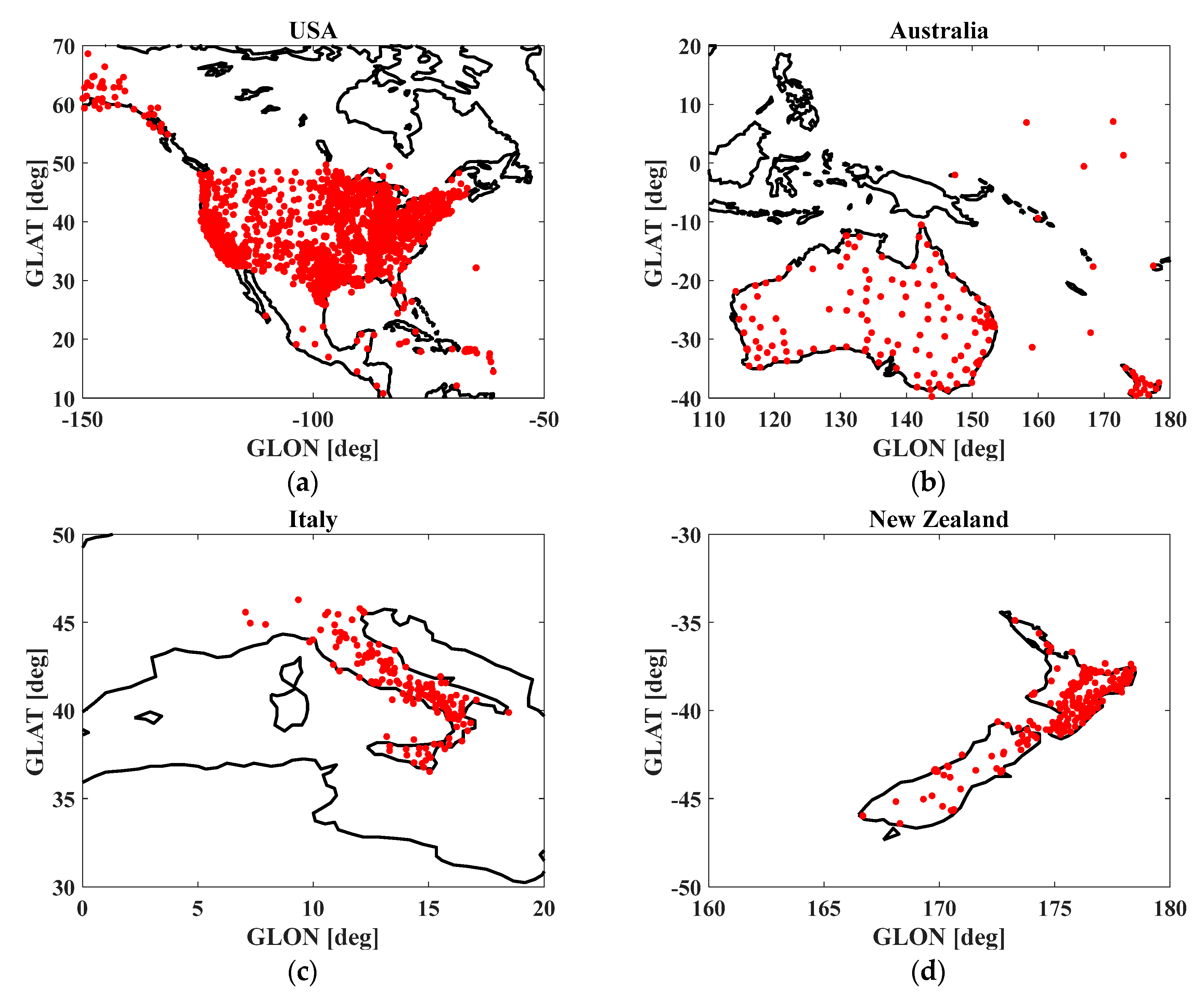
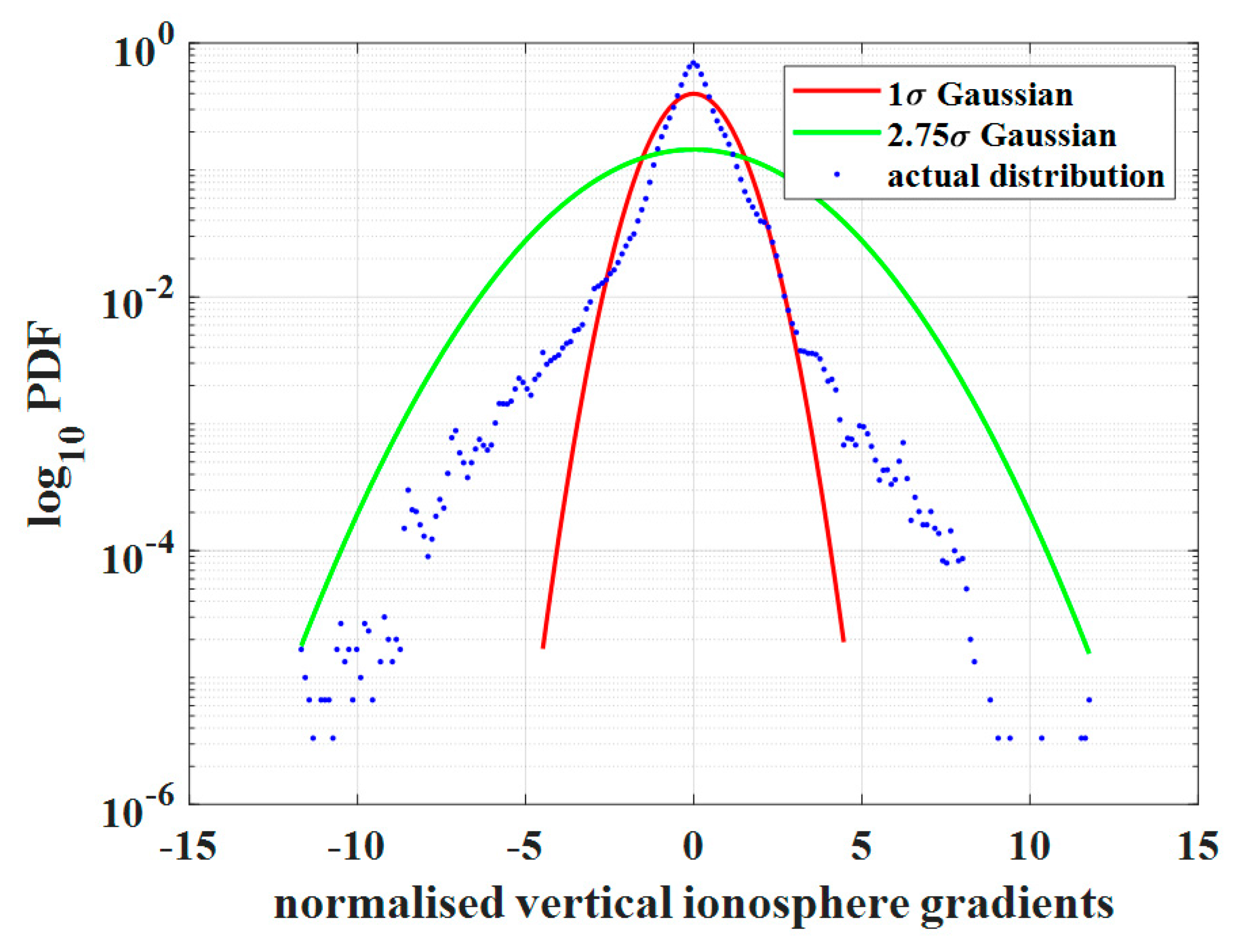
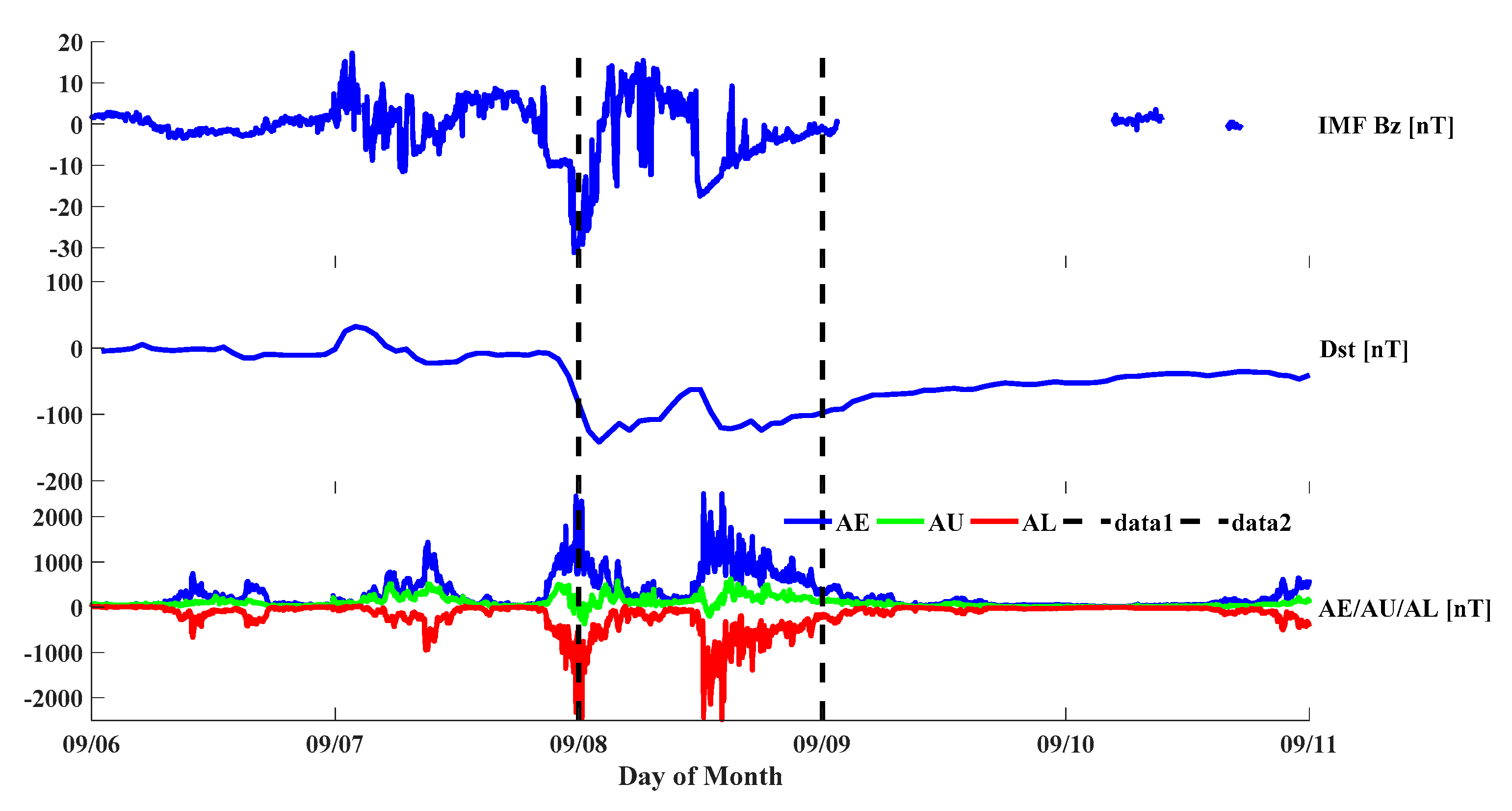
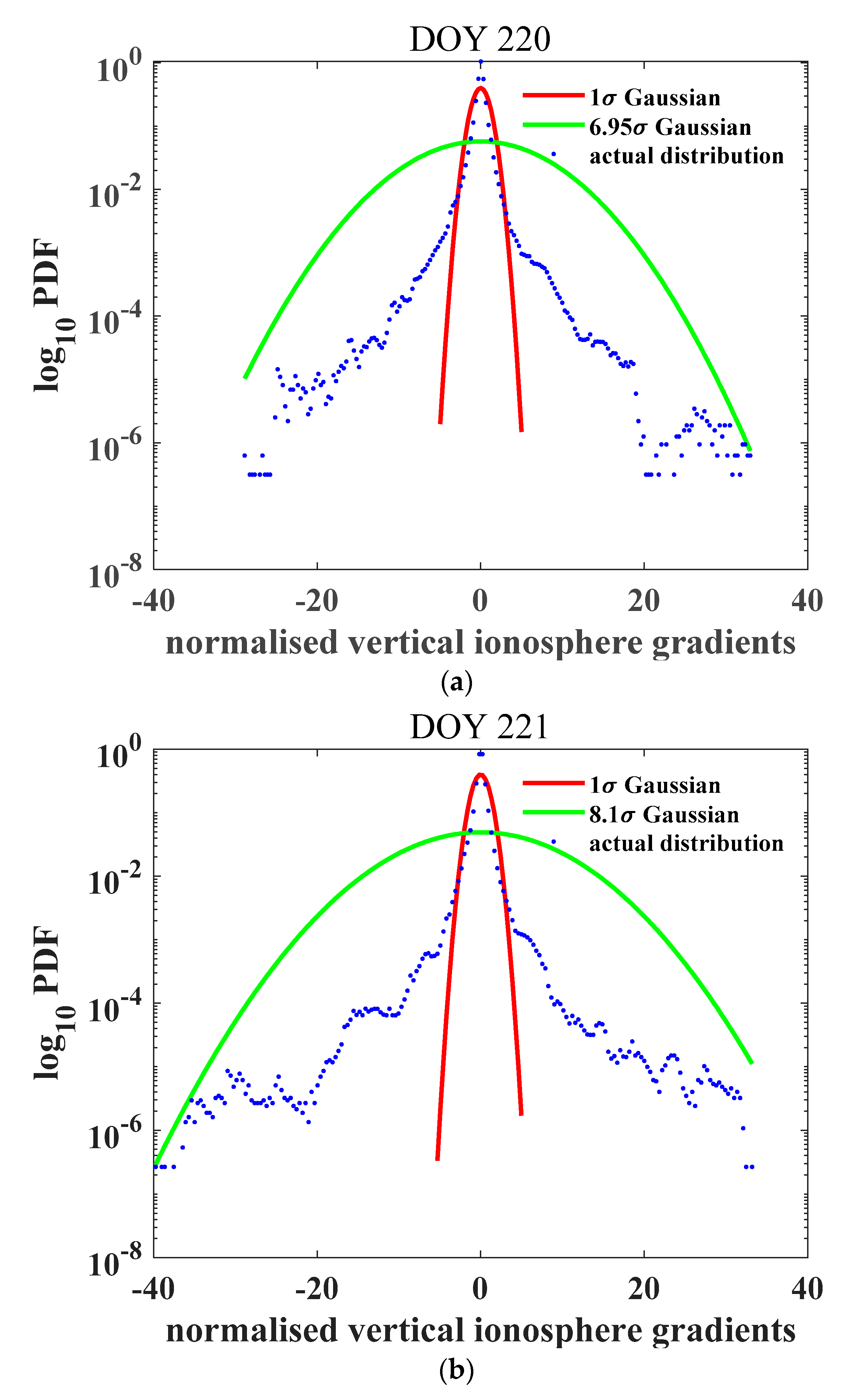

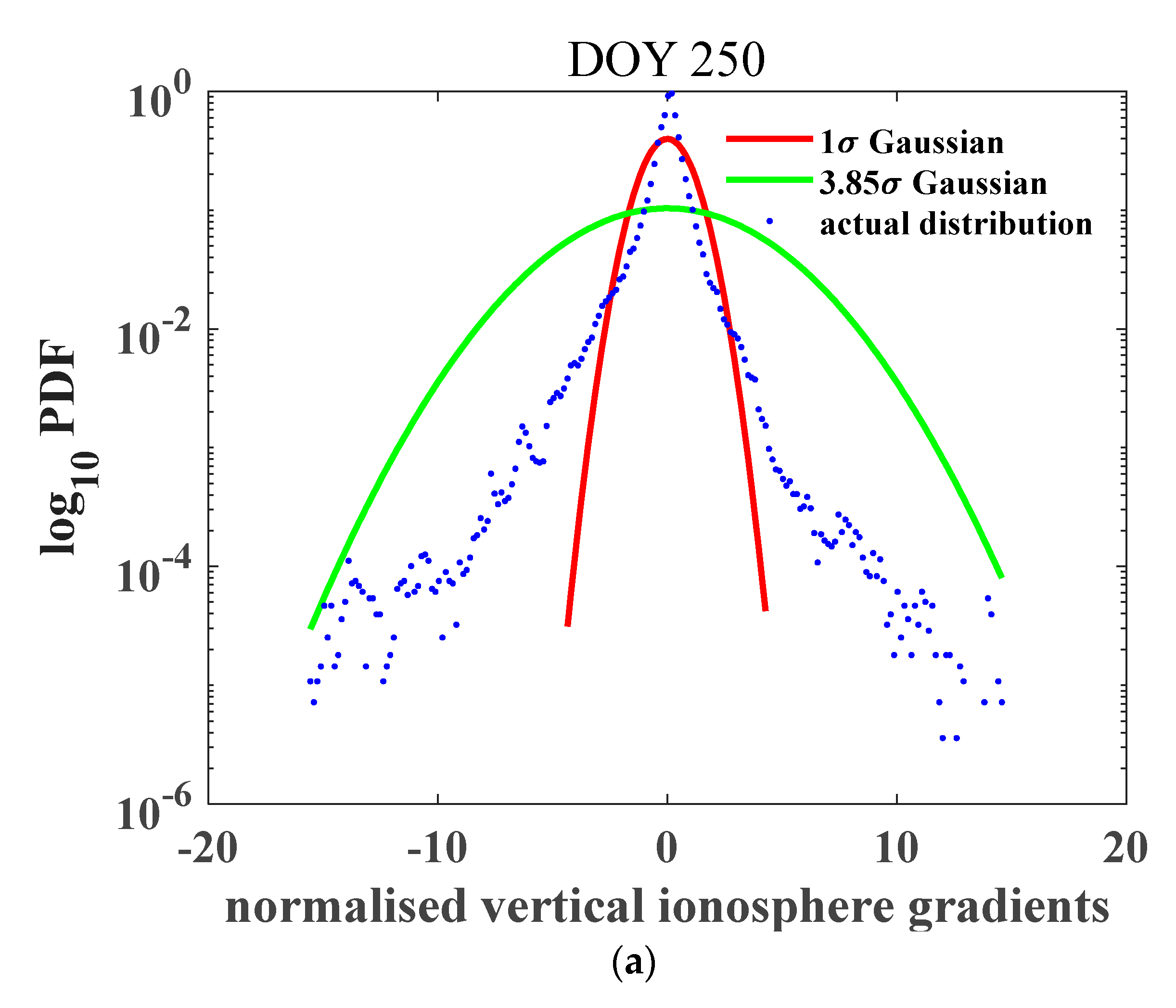


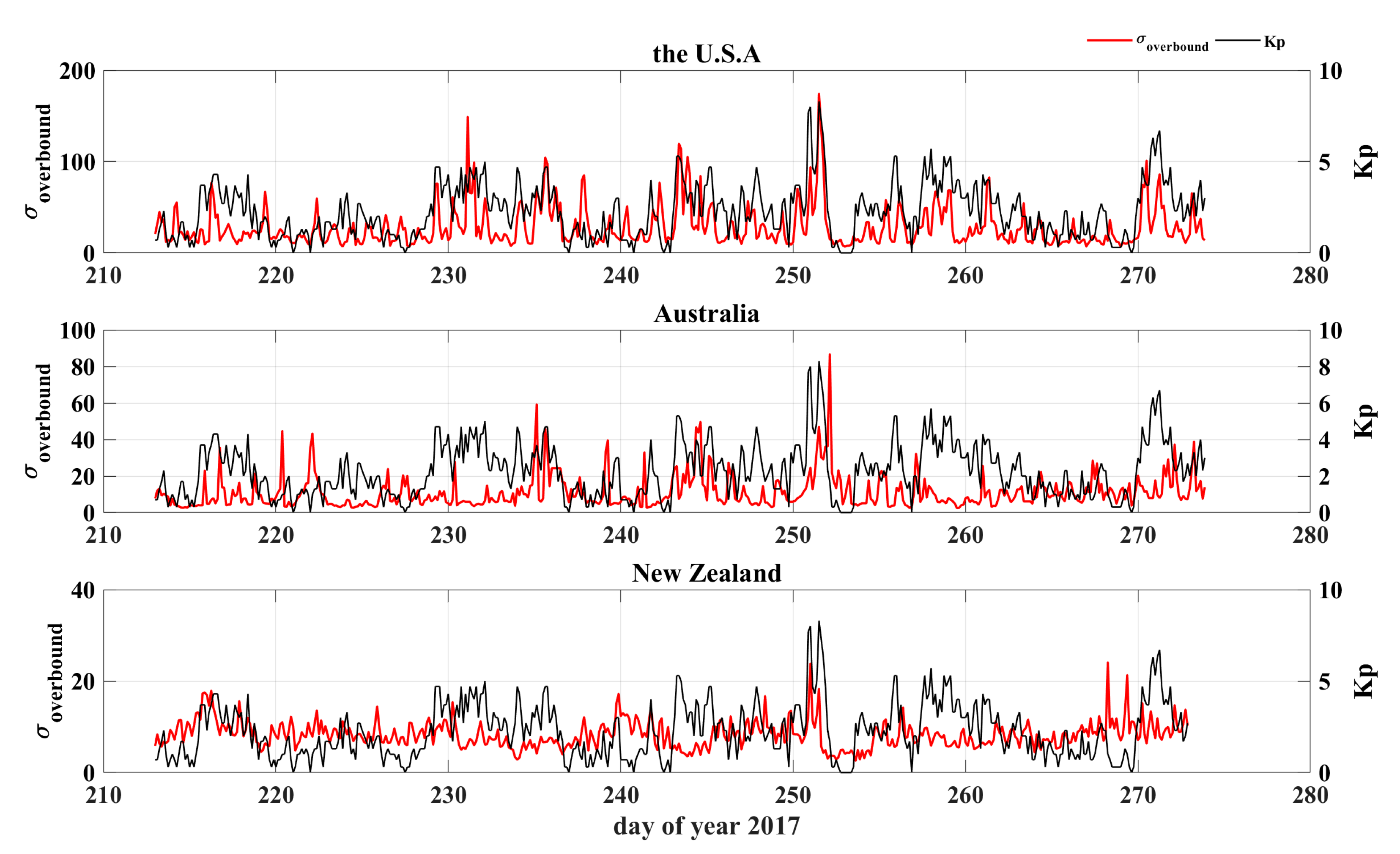
| Day | Ionospheric Gradient | Baseline Distance (km) | |||||
|---|---|---|---|---|---|---|---|
| <10 | 10–15 | 15–20 | 20–25 | 25–30 | 30–35 | ||
| 220 | (mm/km) | 25.42 | 4.62 | 7.38 | 6.96 | 4.76 | 2.91 |
| (mm/km) | 8.49 | 2.99 | 2.73 | 2.04 | 1.62 | 1.25 | |
| 2.95 | 1.50 | 2.55 | 3.35 | 2.85 | 2.30 | ||
| 221 | (mm/km) | 31.62 | 5.79 | 9.47 | 5.90 | 4.63 | 4.36 |
| (mm/km) | 9.19 | 3.03 | 2.80 | 2.07 | 1.65 | 1.40 | |
| 3.40 | 1.85 | 3.30 | 2.75 | 2.75 | 3.10 | ||
| 222 | (mm/km) | 53.94 | 5.09 | 5.72 | 9.48 | 6.51 | 3.89 |
| (mm/km) | 9.69 | 3.03 | 2.56 | 2.06 | 1.68 | 1.34 | |
| 5.55 | 1.60 | 2.10 | 4.55 | 3.85 | 2.90 | ||
| Day | Ionospheric Gradient | Baseline Distance(km) | |||||
|---|---|---|---|---|---|---|---|
| <10 | 10–15 | 15–20 | 20–25 | 25–30 | 30–35 | ||
| 250 | (mm/km) | 70.98 | 24.46 | 47.94 | 23.36 | 16.12 | 10.62 |
| (mm/km) | 15.37 | 5.64 | 6.79 | 4.27 | 3.16 | 2.68 | |
| f | 4.50 | 4.25 | 7.00 | 5.40 | 5.00 | 3.85 | |
| 251 | (mm/km) | 325.31 | 66.61 | 63.02 | 39.50 | 58.61 | 38.63 |
| (mm/km) | 50.41 | 12.53 | 7.85 | 7.15 | 5.26 | 4.56 | |
| f | 6.45 | 5.25 | 8.00 | 5.45 | 11.15 | 8.45 | |
| Day | Regions | <10 km | 10–15 km | 15–20 km | 20–25 km | 25–30 km | 30–35 km | |
|---|---|---|---|---|---|---|---|---|
| 220 | Auroral | (mm/km) | 29.68 | — | — | — | — | — |
| (mm/km) | 9.81 | — | — | — | — | — | ||
| Sub-Auroral | (mm/km) | 28.61 | 19.70 | 7.78 | 7.56 | 5.03 | 1.72 | |
| (mm/km) | 6.44 | 2.70 | 2.42 | 1.80 | 1.21 | 0.96 | ||
| Middle Latitudes | (mm/km) | 18.34 | 5.08 | 5.84 | 4.05 | 4.75 | 3.06 | |
| (mm/km) | 8.66 | 3.17 | 2.94 | 2.15 | 1.93 | 1.48 | ||
| 221 | Auroral | (mm/km) | 37.89 | — | — | — | — | — |
| (mm/km) | 16.18 | — | — | — | — | — | ||
| Sub-Auroral | (mm/km) | 18.39 | 18.38 | 10.05 | 4.89 | 3.11 | 2.48 | |
| (mm/km) | 5.00 | 2.60 | 2.55 | 1.65 | 1.16 | 1.03 | ||
| Middle Latitudes | (mm/km) | 18.38 | 5.50 | 8.13 | 6.13 | 4.90 | 4.59 | |
| (mm/km) | 7.78 | 3.22 | 2.99 | 2.24 | 2.00 | 1.66 | ||
| 222 | Auroral | (mm/km) | 70.32 | — | — | — | — | — |
| (mm/km) | 17.09 | — | — | — | — | — | ||
| Sub-Auroral | (mm/km) | 36.81 | 16.64 | 4.08 | 10.49 | 7.00 | 2.50 | |
| (mm/km) | 6.47 | 2.64 | 1.83 | 1.70 | 1.23 | 1.07 | ||
| Middle Latitudes | (mm/km) | 13.38 | 5.37 | 5.98 | 5.27 | 4.05 | 4.23 | |
| (mm/km) | 7.76 | 3.19 | 2.99 | 2.18 | 1.95 | 1.54 |
| Day | Region | <10 km | 10–15 km | 15–20 km | 20–25 km | 25–30 km | 30–35 km | |
|---|---|---|---|---|---|---|---|---|
| 250 | Auroral | (mm/km) | 83.67 | — | — | — | — | — |
| (mm/km) | 28.8 | — | — | — | — | — | ||
| Sub-Auroral | (mm/km) | 23.41 | 26.07 | 50.98 | 23.99 | 15.42 | 11.01 | |
| (mm/km) | 7.25 | 6.97 | 8.44 | 3.75 | 3.40 | 2.84 | ||
| Middle Latitudes | (mm/km) | 25.64 | 8.16 | 7.48 | 19.94 | 15.82 | 10.85 | |
| (mm/km) | 11.11 | 3.54 | 3.94 | 3.20 | 2.54 | 2.53 | ||
| 251 | Auroral | (mm/km) | 365.64 | — | — | — | — | — |
| (mm/km) | 107.48 | — | — | — | — | — | ||
| Sub-Auroral | (mm/km) | 70.70 | 69.13 | 65.79 | 31.80 | 60.69 | 33.88 | |
| (mm/km) | 15.36 | 9.59 | 9.73 | 5.25 | 5.96 | 4.61 | ||
| Middle Latitudes | (mm/km) | 87.53 | 32.78 | 21.68 | 29.84 | 22.69 | 40.29 | |
| (mm/km) | 15.28 | 4.97 | 4.87 | 5.00 | 3.41 | 4.38 |
| Region | 220 | 221 | 250 | 251 | |
|---|---|---|---|---|---|
| USA | (mm/km) | 21.28 | 17.81 | 61.18 | 148.20 |
| (mm/km) | 4.57 | 4.31 | 9.22 | 19.12 | |
| Italy | (mm/km) | 12.78 | 14.40 | 17.79 | 49.02 |
| (mm/km) | 5.57 | 6.06 | 5.79 | 6.60 | |
| Australia | (mm/km) | 35.17 | 16.52 | 6.96 | 38.95 |
| (mm/km) | 4.55 | 6.11 | 3.36 | 11.76 | |
| New Zealand | (mm/km) | 9.68 | 8.75 | 10.05 | 20.79 |
| (mm/km) | 3.34 | 3.06 | 3.49 | 4.17 |
© 2020 by the authors. Licensee MDPI, Basel, Switzerland. This article is an open access article distributed under the terms and conditions of the Creative Commons Attribution (CC BY) license (http://creativecommons.org/licenses/by/4.0/).
Share and Cite
Zhang, Y.; Liu, Y.; Mei, J.; Zhang, C.; Wang, J. A Study on the Characteristics of the Ionospheric Gradient under Geomagnetic Perturbations. Sensors 2020, 20, 1805. https://doi.org/10.3390/s20071805
Zhang Y, Liu Y, Mei J, Zhang C, Wang J. A Study on the Characteristics of the Ionospheric Gradient under Geomagnetic Perturbations. Sensors. 2020; 20(7):1805. https://doi.org/10.3390/s20071805
Chicago/Turabian StyleZhang, Yixin, Yang Liu, Junlei Mei, Chunxi Zhang, and Jinling Wang. 2020. "A Study on the Characteristics of the Ionospheric Gradient under Geomagnetic Perturbations" Sensors 20, no. 7: 1805. https://doi.org/10.3390/s20071805
APA StyleZhang, Y., Liu, Y., Mei, J., Zhang, C., & Wang, J. (2020). A Study on the Characteristics of the Ionospheric Gradient under Geomagnetic Perturbations. Sensors, 20(7), 1805. https://doi.org/10.3390/s20071805





